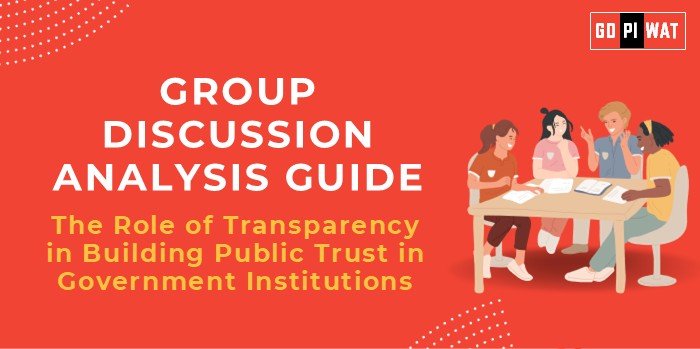📋 Group Discussion Analysis Guide: The Role of Transparency in Building Public Trust in Government Institutions
🌟 Introduction to Transparency and Public Trust
- 📜 Opening Context: “Transparency serves as the cornerstone of a functional democracy, ensuring accountability and fostering public trust in governance. In the age of information, governments worldwide face mounting demands for open and accessible communication with their citizens.”
- 🌍 Topic Background: Transparency in governance gained momentum with global movements like Open Government Partnership (OGP) and has been a focus of institutions like the United Nations. Technological advancements have further catalyzed initiatives such as e-governance and Right to Information (RTI) laws.
📊 Quick Facts and Key Statistics
- 🌍 OGP Membership: 78 countries committed to open governance, illustrating its global scope.
- 📊 Corruption Perception Index (CPI): Transparency International’s 2023 report ranks nations based on perceived corruption.
- 🇮🇳 RTI in India: Over 8.1 million RTI queries filed annually (CIC, 2023).
- 🇪🇪 E-Governance in Estonia: 99% of government services are online, exemplifying global leadership in transparency.
🏛️ Stakeholders and Their Roles
- 🏢 Government Bodies: Enact and enforce transparency laws, streamline public service delivery.
- 👥 Citizens: Demand accountability and utilize tools like RTI to monitor governance.
- 🌍 Non-Governmental Organizations: Advocate for openness and combat corruption.
- 🛡️ Global Organizations: Support frameworks like the UN’s Sustainable Development Goal 16 for effective governance.
🏆 Achievements and Challenges
✨ Achievements:
- 📜 RTI Act (India): Empowered citizens to question government decisions; a pivotal transparency tool.
- 💻 Digital Governance: Platforms like DigiLocker simplify access to public services.
- 📉 Corruption Reduction: Estonia’s e-Governance has decreased bribery by over 50%.
⚠️ Challenges:
- ⚔️ Resistance to Change: Bureaucratic inertia hampers transparency initiatives.
- 🌐 Digital Divide: Marginalized groups often lack access to online tools.
- 🔒 Cybersecurity Concerns: Sensitive data exposure, as seen in breaches like the AIIMS attack in 2022.
🌍 Global Comparisons:
- 🇪🇪 Estonia: Digital-first governance serves as a global benchmark.
- 🇧🇷 Brazil: Struggles with implementing anti-corruption measures despite transparency laws.
📖 Case Study:
Kerala’s e-Governance Model achieved near-universal digital literacy, fostering greater trust in governance.
💬 Structured Arguments for Discussion
- ✅ Supporting Stance: “Transparency enhances accountability, exemplified by the RTI Act reducing corruption in public offices.”
- ❌ Opposing Stance: “Overemphasis on transparency risks inefficiency, as seen in bureaucratic delays due to excessive scrutiny.”
- ⚖️ Balanced Perspective: “While transparency builds trust, achieving it requires addressing digital inequities and security risks.”
📌 Effective Discussion Approaches
- 🎯 Opening Approaches:
- 📊 “With 8.1 million RTI queries annually in India, transparency is reshaping citizen-government relationships.”
- 🌍 “Estonia’s 99% online services demonstrate how digital transparency builds public trust.”
- 🛡️ Counter-Argument Handling:
- 📖 Data-backed rebuttals: “Although RTI is impactful, digital tools can expand its reach to underserved populations.”
📊 Strategic Analysis of Strengths and Weaknesses
- 🌟 Strengths: Empowered citizens, reduced corruption.
- ⚠️ Weaknesses: Bureaucratic inefficiencies, cybersecurity gaps.
- 🌟 Opportunities: AI-driven transparency tools, global leadership in governance.
- ⚠️ Threats: Resistance to digital adoption, data privacy issues.
📚 Connecting with B-School Applications
- 📖 Real-World Applications: Analyze how transparency reforms impact financial management, HR, or CSR.
- 🗨️ Sample Interview Questions:
- ⚖️ “How can governments balance transparency and efficiency?”
- 💻 “What role does technology play in fostering trust in public institutions?”
- 📖 Insights for B-School Students: Explore transparency as a driver for ethical leadership and innovation.


